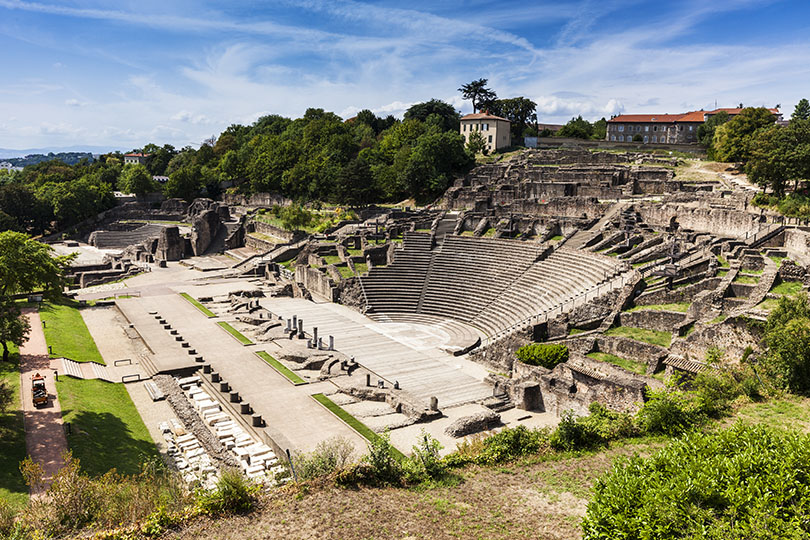
15 BC Ruins of Roman Theatre in Lyon; (c) benrut
Lyon History
This charming city was the capital of the Gauls during the Roman Empire. By the Middle Ages, the Gauls ruled most of what we know today as France. The districts of Old Lyon, Fourvière hill, Presqu’île and the slopes of the Croix-Rousse are on the UNESCO World Heritage List for good reason.
Located in the Auvergne-Rhône-Alpes region, at the confluence of the Saône and Rhône Rivers, the city of Lyon is dominated by two hills, Fourvière to the west and Croix-Rousse to the east.
The long history of Lyon the Celtic era to its founding by the Romans with the capital of Trois Gaules in the 1st century BC. Consequently, Roman vestiges of the medieval streets on the slopes of Fourvière and the Renaissance dwellings of Vieux-Lyon, from the peninsula with a wealth of classical architecture to the slopes of Croix-Rousse with its very particular canut dwellings, which bear witness to an essential page in the history of the laboring classes of the 19th century.
There are buildings dating to the late 12th century and many extending to the 18th century illustrating the transition from Gothic to French Renaissance style. Those architectural systoles are most evident in Vieux Lyon and Croix Rosse. Note the late 11th-century Manécanterie; the Ainay Abbey Church (1107), of pure Romanesque style.
The Cathedral of Saint John the Baptist (1160-1481), which retains a remarkable degree of stylistic homogeneity, despite the long period of construction; the Church of St Nizier, begun in the 14th century and completed in 19th century, with its Flamboyant Gothic nave, its typical classical Renaissance façade and its neo-Gothic spire.
The imposing Hôtel de Ville (1646-1703); the 17th-18th century Hôtel-Dieu built over a medieval original; the Loge du Change (1745-80), now in use as a Protestant church; the Fourvière Basilica (1872-96), one of the most important landmarks of the city; and the Weaving School, the work of modernist architect Tony Garnier (1927-1933).
While preserving the richness of its World Heritage Sites, Lyon is expanding eastwards and modernizing its southern district where two rivers meet. Unlike many other cities where the centre was destroyed in order to be rebuilt in the same place with new architecture, Lyon’s centre has shifted location, enabling the safeguarding the history of the city and its quality of life.
On this exceptional urban fabric, inscribed in the medieval precinct that endured until the 19th century, the majority of conserved & restored buildings represent an extremely long period of its development.
